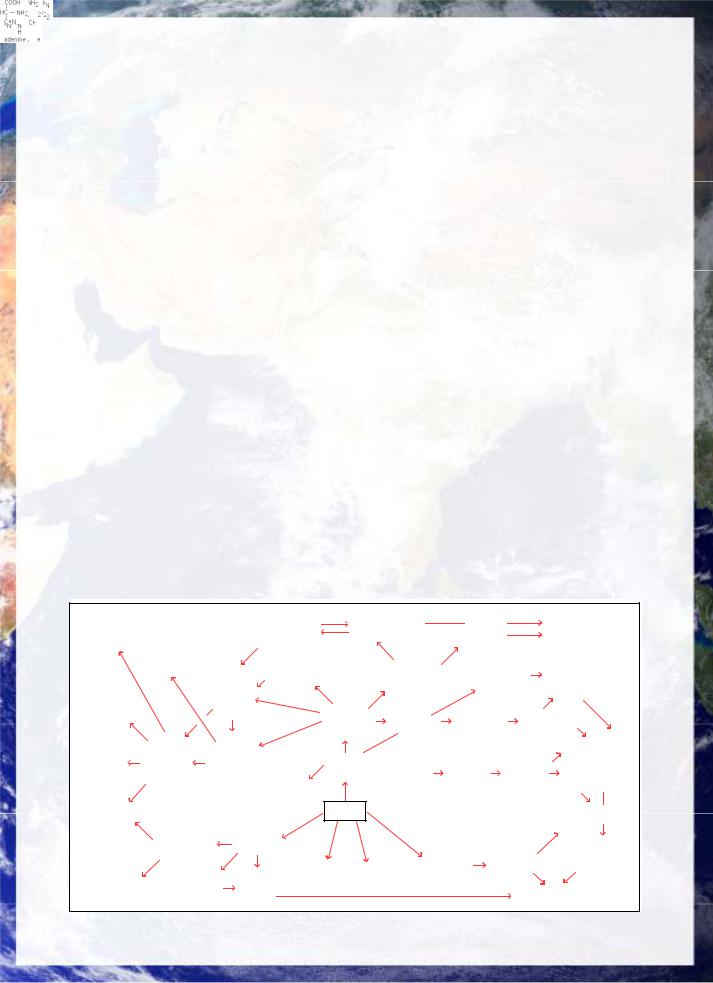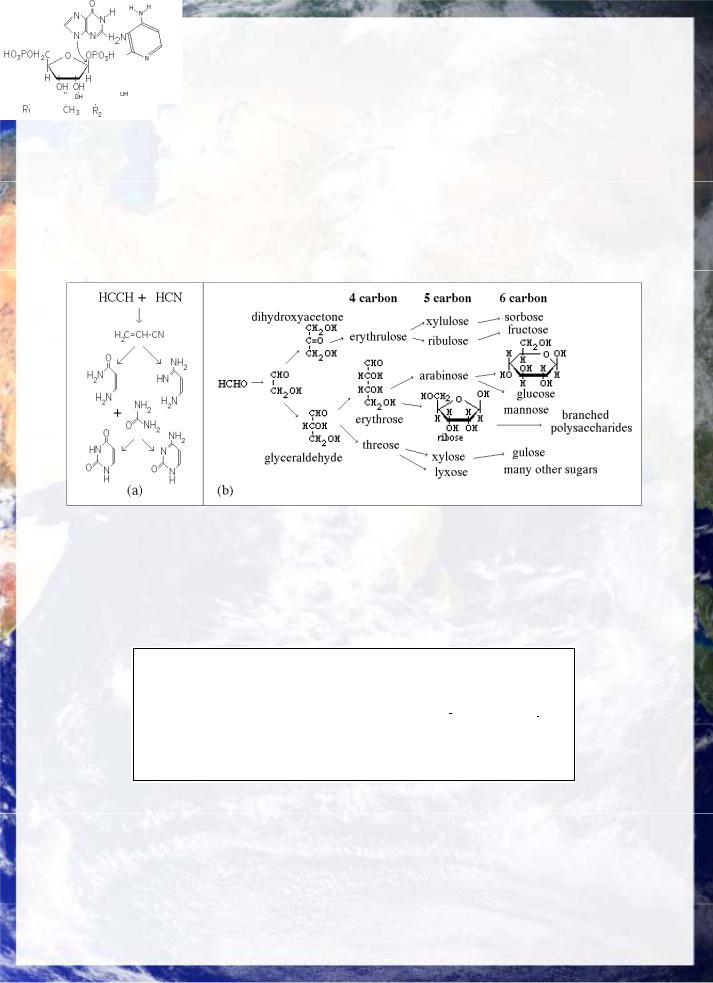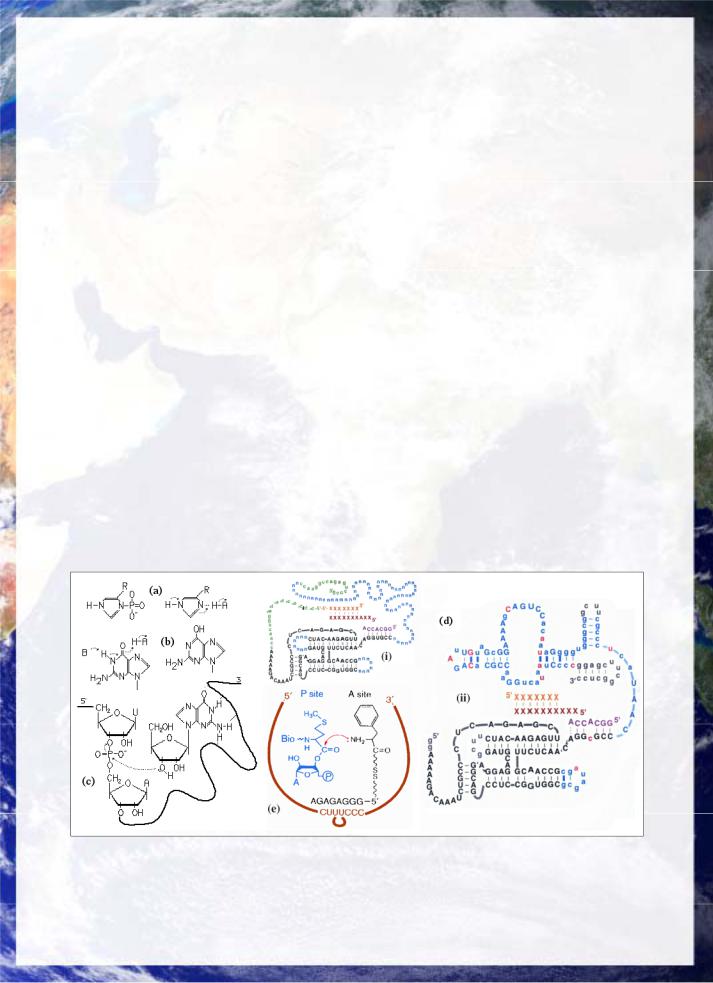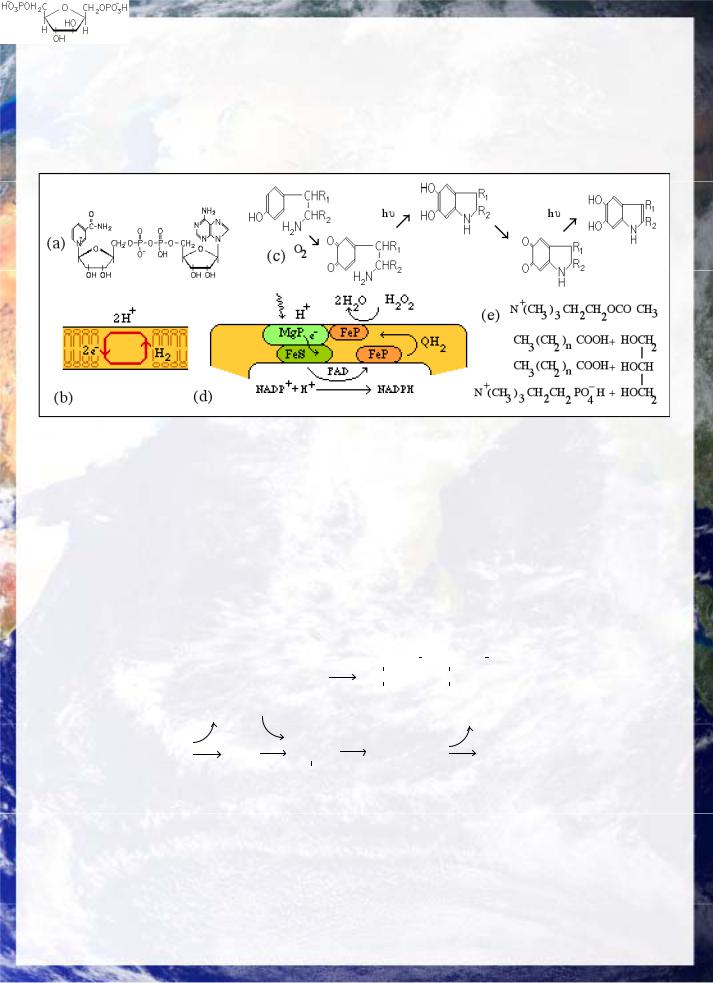
Biocosmology - Chris C King
.pdf
Page 11
as a primitive genetic system and both include adsorbent and catalytic sites (Cairns-Smith 1982, Weiss 1981). Clays also appear to play a key role in stabilizing ribonucleotide polymerization (Ferris et.al. 1996, Ferris 2001). The mineral interface involves crucial processes of selective adsorption, chromatographic migration, and fractional concentration. In addition a
compact metabolic phase may be reinforced by a phase transition to K+ ion - polypeptide water gel formation. Such process may be essential to explain how rich concentrations of molecules such as polypeptides and oligonucleotides could have occurred over geologic time scales. Interface interactions are characteristic of the the diversity micro-environments brought about by non-linear interaction on the planetary surface. They include redox and electron transport processes such as the FeS catalyzed reactions suggested by Wächtershäuser and others. A key interface is likely to have been a four-way interaction over time between phosphate-nucleotide dehydration processes (see RNA section), negatively charged polynucleotides and positively charged silicate mineral surfaces, the redox potential of FeS systems, and polypeptide-induced water structures interacting with positive ions to undergo phase transition to compact gels (Pollack 2001).
The above processes between them constitute the major quantum bifurcations in the free interaction of the elements. They are also the central processes operating in biogenesis. Put together this says the following: The central biogenesis pathways are themselves results of the central interactive quantum bifurcations of symmetry-breaking and its resulting non-linear interactions. While life may be possible from other combinations of elements and other temperatures and pressures, life as we know it has taken the ‘sang raal’ or blood-royal route of quantum cosmology.
6: STRUCTURAL DYNAMICS OF THE CORE POLYMERIZATION PATHWAYS
The initial polymerizations of energetic multiple-bonded monomers in the reactions in figs 15 and 16 form a paradoxical information puzzle from a quantum-chemical point of view, because they provide some of the richest examples of growth in quantum-mechanical complexity, in which a relatively small number of simpler precursors give rise to increasingly complex product structures whose properties cannot be fully predicted from the simpler initial conditions.
H2C=O in aqueous solution gives rise to 4 to 7 carbon sugars, including ribose, as well as branched polysaccharides. HC∫N
gives rise to heterocyclic purine and pyrimidine nucleic acid bases, and in addition several amino acids, polypeptides, porphyrins, and many other types of biomolecule (Lowe et. al. 1963, Calvin 1969, Mizutani et. al. 1975). A similar array of products arises from hybrids such as cyanogen N∫C-C∫N (Schwartz et. al. 1975) and cyanoacetaldehyde N∫C-CH2-H2C=O.
Although several of these products, such as the ring polymers adenine (HCN)5 and ribose (H2CO)5 are stable product
structures, many of the more complex products, such as particular oligopeptides are metastable or stochastic products of the reaction. These conditions differ markedly from the current biochemical regime in which structurally-stable metabolic pathways are maintained through genetically-coded enzyme catalysis except where recombinational stochasticity is specifically initiated as in generation of antibody immuno-diversity.
Since the initial conditions do not contain sufficient information to determine the final products, the system contains many potential outcomes. The lower energy configuration of key products, such as adenine's resonance stabilization, leads to some stable conformations based on free energy. Stochastic indeterminacies in the interaction of simpler molecules can lead to multiple branching pathways. Products of increasing complexity such as polypeptides possess increasingly active catalytic potential, which may alter the structural-stability of polymerization to favour certain types of product. The dynamics may trigger a sequence of autocatalytic bifurcations, forming catalytically attracting molecular products. These reaction pathways are capable of producing a vast variety of complex molecules with generic relationships to key biomolecules, including amino acids, polypeptides, HCN polymers, purines, pyrimidines and porphyrins.
hν |
|
|
other |
|
glycine |
purines |
|
|
|
|
|
|
|
amino acids |
|
|
lactic acid etc. |
|
|
polypeptides |
HCN |
hν |
amino acids |
hν |
|
e- |
|
|
|
porphyrins |
|
pyrimidines |
Fig 15: Known product structures and pathways in HCN polymerization (ex. Mizutani et. al.).
Both HCN and HCHO polymerizations have prominent cyclic products which act as spontaneous end points of

Page 12
polymerization, because cyclization mutually neutralizes reactive moieties. The purines, pyrimidines, ribose and porphyrins all display structure consistent with being cyclic terminators. The capacity of polymers for non-periodic primary sequencing gives rise to complex tertiary structures, which are fractal as a result of structure on several overlapping scales from the atom, through local groups, to structures such as a-helices through to global conformation changes. This fractal nature is reflected both in the geometry and the quantum energetics of molecular transformations (Ansari et. al. 1985, Liebovitch & Toth 1991). Substrate form is dependent firstly on local active sites, and in turn on the global tertiary structure of catalytic molecules.
Although the first syntheses produced the purines adenine and guanine readily, cytosine and uracil, the complementary pyrimidine bases making up the other half of the pair A-U and G-C, however Stanley Miller, forty three years after his original pioneering experiment in spark synthesis, with Michael Robertson, discovered a way for the primordial pond to make them in high yield. Although urea is produced in Miller's original experimental setup, it never reaches a high enough concentration. When he added more urea, it reacted with cyanoacetaldehyde, another by-product of the spark synthesis, churning out vast amounts of the two bases. Urea would have been able to reach high enough concentrations as shallow pools of water on the Earth's surface evaporated. (Cohen 1996, Horgan 1996).
Eschenmoser (1992) has found that glyceraldehyde phosphate in the presence of HCHO will produce 5-carbon sugars with up to 33% ribose. In the absence of HCHO the reaction tends to produce 6-carbon sugars. The phosphate-induced reaction is key here because RNA, ATP and glycolysis all involve phosphate dehydration energy. This indicates a specific link to phosphate energy primordial to the formation of oligonucleotides and even ribose.
Fig 16: (a) One of several synthesis pathways for pyrimidines. (b) Sample HCHO polymerization routes. Phosphorylation of the oligo-aldehydes causes the reaction to favour ribose. (Eschenmoser 1992).
7: RNA AND COSMOLOGY
In 1981 Francis Crick commented that 'the origin of life appears to be almost a miracle, so many are the conditions which would have to be satisfied to get it going." (Horgan 1996) Now, several findings bolster the dominant theory of genesis - that life began in an era in which RNA was both the genetic and catalytic basis - the RNA era (Gilbert 1986, Benner et. al. 1989, 1993) in which simple replication and 'enzymatic' processes based on RNA catalysis established evolutionary biochemistry.
4 1
3 2
(a) |
(b) |
(c) |
Fig 17: (a) MgATP-complex illustrates linkage between primal stability structures. Cyclic pentamers of HCN (adenine) and HCHO (ribose) are linked by phosphate dehydration, stabilized by cation and water structures. (b) Heterocyclic form of heme. Porphyrins have also been detected in primal syntheses. (c) Nucleophilic attack of adenine N9 on ribose.
The general outLINEs are clear. Ribose as (HCHO)5, unlike the deoxyribose in DNA, has plausible prebiotic syntheses.
RNA's capacity to both form double-helices, like DNA and to also three-dimensional tertiary structures similar to proteins, fig 11(a), through base-backbone bonding to ribose causes RNA to have both genetic and catalytic capacity. Simple biological RNAs have been demonstrated to have autocatalytic self-assembling capacity. The catalytic activity of polynucleotides, hinges on various forms of proton transfer fig 18(a,b,c) (Pace and Marsh 1985), in particular transesterification.
The essential core of the protein-assembling ribosome remains RNA as does the signal recognition particle which shepherds nascent proteins through the membrane. The ancient fossil nucleotide coenzymes including ATP, NAD, coenzyme-A and Vitamin B12 are all ribonucleotides. Eucaryote organisms continue to have a massive commitment to RNA processing within the nucleus, including the use of many small small nuclear ribonucleotides or snuRps involved in RNA splicing. This

Page 13
suggests eucaryotes have never fully transferred from an RNA-based metabolism. Reverse transcriptases also remain ubiquitous and essential for such basic functions as telomere extension, and have a common evolutionary tree, giving retrotransposons and retroviruses a potentially ancient origin in the commonality of the RNA era.
There is still debate about whether RNA was actually the primordial genetic molecule and other hybrid molecules such as peptide-nucleic acids which use peptide rather than sugar linkages also have genetic potential and plausible prebiotic status (Nelson et. al.), however it is clear RNA itself has generic status as a cosmological molecular structure on several grounds. Adenine is a principal thermodynamic product of HCN polymerization in industrial yields. All of A, G, U and C now have prebiotic status as favoured products of such reactions. Ribose is an optimal sugar conformationally in terms of permitting complementary double helix formation, and has a synthesis route from glyceraldehyde phosphate. The complementations of A-U & G-C posses a type of structural optimality among the bases. The heterocyclic polymers are restricted in their variety by the positions of N atoms required by the polymerization process. The tautomeric states of A, U, G and C indicate AU and GC may be optimal for base-pairing among close prebiotic variants.
The nucleotide unit, as exemplified in ATP consists of a direct concatenation of key products of HCN and HCHO polymerizations. Adenine and ribose are the cyclic pentamers of HCN and HCHO linked via dehydration to a dehydrating
oligo-phosphate giving it the statues of a generic structure, fig 17(a) stabilized by water and Mg2+, Positive ions also play an important role in stabilizing monoand oligo-nucleotides. It was originally synthesized under primitive conditions by
Ponnamperuma et. al. (1963). Mg2+ balancing the negative phosphates.
ions are also bound to transfer RNA and play a critical role in transesterification, The fact that the polymerizing phosphodiester bond results from the removal of H2O
from phosphate suggests that phosphate was the active moiety linking of the base-sugar-phosphate complex, fig 17(c) and thus drove the entire formation of nucleic acids.
RNA proved difficult for a time to induce into complementary replication in enzyme-free systems, but its relative difficulty of synthesis may be essential to its function. It is necessary that RNA be thermodynamically unstable, or life could not exist dynamically but would 'crystallize' all the way to non-genetic polymers. A variety of partial model systems of complementary replication have been realized by Orgel and his coworkers, however instabilities in polymerization have hindered experimental enzyme-free complementary polymerization of RNAs (Orgel 1992). It is clear that a regime of polynucleotide chemistry would have to have occurred stably over evolutionary time scales for an RNA-based form of life to evolve to the point where it had established translation and captured metabolic synthetic pathways.
Ferris has reported (Ferris et. al. 1996, Ferris 2001) that he has found a means by which the first large chains could have been forged. When his team added montmorillonite, a positively charged clay believed to be plentiful on the young Earth, to a solution of negatively charged adenine nucleotides, it spawned RNA 10-15 nucleotides long. If these chains, which cling to the surface of the clay, were then repeatedly 'fed" more nucleotides by washing them with the solution, they grew up to 55 nucleotides long. Ferris notes the clay gets RNA off the hook of having to take on the tasks of information storage and catalysis in one fell swoop. It would catalyze RNA synthesis, stocking pools with a large range of RNA strands that, as Szostak and others have shown, would evolve a catalytic capacity of their own. (Horgan 1996). Thus complementary replication can come into existence after a phase of single-stranded polymerization has given rise to a fractal RNA environment with a diverse array of oligomeric and polymeric structures, which in turn feedback autocatalytically on replication and monomer synthesis.
Fig 18: The ribozyme world: (a) Phospho-imidazole. Proton transfers in (a) imidazole, (b) in base tautomerization, (c) in Tetrahymena intron. (d) The first effective ribozyme RNA polymerase (ii) - a 172 unit molecule bred by molecular selection from a ligase ribozyme (i black section) through selective evolution of a pool of other intermediates (i coloured). This ribo-RNA polymerase will faithfully perform complementary replication of oligo-ribonucleotides of arbitrary sequence up to 14 units long with accuracies of up to 98% per base pair (Johnston et. al .2001). (e) Trans-acting ribozyme replicates key sequence and structure of the ribosome (Zhang and Cech 1997, 1998).
A central scenario out of many, including volcanic hot pools, and hydrothermal vents, is the three-phase boundary of a phosphate-rich, clay shore line under tidal or weather-related variations in a pool in which the margin is reversibly dehydrated e.g. by sun-drying. Both clays and volcanic basalts have been cited as possible mineral interfaces. Precipitated phosphate at

Page 14
37o, leads to pyrophosphate formation and hence phosphate bond energy (Hermes-Lima 1990). Since the energy for nucleotide polymerization is driven by H2O removal, reversible dehydration of a medium containing phosphate, bases and
sugars provides one of the most direct and simple routes to polynucleotide formation.
8: DIVERSE HORIZONS OF THE RNA EPOCH
A whole new field of RNA research has developed from the discovery of spontaneous splicing of RNAs in living systems by Tom Cech (1986a) and the demonstrated capacity of such RNAs to function as catalysts in transesterifications and the work of Jack Szostack's teams in selective RNA catalysis (Horgan 1996). This immediately made the idea of the RNA world before proteins a natural hypothesis. This work has grown with artificial selective evolutionary studies, culminating with the development of a ribozyme which is capable of high fidelity complementary replication of short RNA oligomers of arbitrary sequence (Johnston et. al. 2001). This has become a turning point in the credibility and maturity of the RNA world as a precursor to DNA-based life which can develop as an autonomous molecular system.
The model has been extended to others for RNA-based error-correction, synthetases and the ribosome (Bass and Cech 1984, Cech 1986b, Zany and Cech 1986, Garriga et. al. 1986, Weiner and Maizels 1987). Modified ribozymes are capable of acting as polymerases which can replicate complements to subsections of themselves (Green et. al. 1990, Doudna et. al. 1991).
The discovery that RNA appears to be the agent of peptide-bond synthesis in the modern ribosome (Guthrie 1992, Pace 1992, Noller et. al. 1992) and the capacity of modified ribozymes to act as amino-acyl esterases (Picarilli et. al. 1992), the first step of ribosomal action in protein synthesis, establish RNA has the potential to act as synthetase as well as transfer, messenger and ribosomal functions. This gives RNA the capacity to act on its own to catalyze both its own replication and the ordered polymerization of proteins. Simpler model systems have also been advanced of the stereospecific capacity of D-nucleotides to act as a catalyst of L-amino acid polymerization (Lacey et. al. 1990). These results enable RNA to be the key prebiotic molecule generating ordered polynucleotide and polypeptide structures.
Szostak and Wilson (1996, Wilson and Szostak 1995) have evolved ribozymes capable of a broad class of catalytic reactions. The catalysis of previous ribozymes tended to involve only the molecules' sugar-phosphate "backbone," but these could also promote the formation of peptide bonds (which link amino acids together to form proteins) and between carbon and nitrogen. (Horgan). David Bartel a former member of Szostak's team, has evolved RNAs that are as efficient as some modern protein enzymes. The problem with most ribozymes is that they are as likely to snip an RNA molecule apart as stitch one together which makes copying a molecule fifty nucleotides long (the minimum size necessary to catalyze a chemical reaction) difficult or impossible. Bartel's new ribozymes, on the other hand, can stitch small pieces of RNA together without breaking larger molecules apart. These ribozymes use high-energy tri-phosphate bonds similar to ATP as their fuel, speeding the reaction up several million-fold. (Cohen)
Zhang and Cech have reported a step towards linking amino-acids. They isolated RNAs that could efficiently link specific amino acids together (Zhang and Cech 1997). These pseudo-ribosomes were selected from a random pool of 1015 synthetic RNAs. They then elicited a trans-acting by coupling one of the amino acids to a short RNA with complementary sequence to the ribozyme achieving a ribozyme which would join a ribosynthetase-amino acid to form a peptide bond with another thus replicating even more closely ribosomal function. They also found that a small region of many of the RNAs they selected was 70 per cent identical to some regions of the ribosomal RNA. "We not only copied ribosome function, we seemed to have recapitulated its evolution," says Cech. The two researchers then removed or mutated these sequences in the synthetic RNAs (Zhang and Cech 1998) any change to this region cut the activity of the RNA by a factor of between 20 and 600. This suggests this region in both the modern ribosome and the synthetic RNA may have the same role in the fusion reaction, such as holding the amino acids in the correct position and that they may have converged on the same molecular solution.
The alternative hypothesis is that replication began with a molecular hybrid – PNA, or peptide nucleic acid. PNA has a similar structure to RNA except for having a peptide backbone based on prebiotically abundant glycine and can co-instruct complementary RNA sequences and vice versa (Böhler, Nielsen and Orgel 1995). The units of PNA are joined together with peptide links like those in proteins which may not present the instabilities which sugars may have faced on the early earth. Matthew Levy and his colleagues (Nelson, Levy and Miller 2000) persuaded up to 78 per cent of plausible prebiotic chemicals to transform into PNA backbone subunits amino-ethyl glycine or AEG. The acetic acid derivatives of the bases A, G U and C can likewise be generated from prebiotic reagents including NH4CN with glycine and cyanoglyceraldehyde. AEG
units link up readily at 100 deg C, which may have been common temperature four billion years ago when our planet was rich in volcanic activity. PNA is an alternative route to establishing the RNA era which also has a good cosmological foundation.
9: UNIVERSAL STABILITY STRUCTURES IN MOLECULAR BIOLOGY
The previous discussion of the RNA era can unravel a double-bind that is central to biogenesis - how did the core biochemical pathways become generated? The traditional viewpoint is that they were successively created starting from a simple chemical-feeding heterotroph, through mutational evolution, building one-by-one the protein components necessary to make a working whole. This however does not explain how integrated systems such as electron transport and the citric acid cycle could have functioned at all with only a vestigial complement of enzymes.
This suggests that many of the major features of molecular biology are generic structures which can come into existence under suitable conditions, through bifurcation, independently of the emergence of genetic RNA, and that these were subsequently captured by genetic takeover as genetic complexity permitted. Such generic structures include the polymeric structure of proteins and nucleic acids, nucleotide coenzymes, bilayer membrane structure and the topological closure of the cell, ion transport and membrane excitability, membrane-bound electron transport, glycolysis and the citric acid cycle.
Such a perspective has far-reaching consequences for molecular biology in cosmological terms, for while the details of mutational evolution will be unique to each environment, the major features underlying biology could be universal.

Page 15
9.1 Nucleotides and the Nucleotide Coenzymes.
The nucleotide co-enzymes are widely regarded as ancient molecular fossils retained from the RNA-era. In addition to the key role of ADP and ATP as energy currency in the bio-metabolism, GTP is used in protein synthesis, and the nucleotides UDP and CDP are carriers of glucose and choline and other membrane components. Model prebiotic reactions have successfully coupled UDP and CDP to glucose and choline (Mar et. al. 1986). Both NAD, and FAD function as carriers of redox energy. Coenzyme A consists of adenosine coupled to pantothenic acid and functions as a carrier of acyl and other groups via the terminal SH bond (Reanney 1977). Vitamin B12 also illustrates how a di-nucleotide can bind a metallic porphyrin ring. Eschenmoser (1988) has also discovered a plausible prebiotic pathway generating the more complex B12 molecule which involves two nucleotides and a Co-porphyrin. Prebiotically such a molecule could have also utilized a
lowered Fe2+– Fe3+ activation energy as a carrier of electrons.
CCY |
CGY |
|
CUY |
n |
|
CAY |
|
Pro |
N-base |
|
V L IP |
o |
|
N-base |
p |
GCY |
GGY |
|
GUY |
n |
|
GAY |
|
abundant |
|
o |
|||||
|
|
||||||
Ala |
Gly |
|
V LIP |
p |
amides |
Acid |
l |
|
|
|
UUY |
|
UAY |
||
UCY |
UGY |
|
|
a |
|||
|
o |
|
|||||
Ser |
Cys |
|
VLI P |
|
Stop |
r |
|
|
l |
|
|||||
|
OH SH |
|
AUY |
|
AAY |
|
|
ACY |
|
a |
|
|
|||
AGY |
|
|
|
||||
Thr |
Ser |
|
VL I P |
r |
|
N-base |
|
Fig 19: The genetic code contains evidence for several primal bifurcations (King 1982). Centre position AU selects polar /non-polar as broad groups. VLIP are Val-Leu-Ileu-Phe. First position G determines primally abundant amino acids. Expansion: first codon C and A fix synthesis routes from Glu and Asp Subsequent bifurcations include H-bonding block and acid-base .
9.2 Translation.
According to the genetic takeover hypothesis, evolution of RNA captured existing stability structures in the prebiotic medium. The most central of these is clearly the use of proteins as coded enzyme catalysts. Such a process could only have occurred in an environment in which RNAs coexisted with amino-acids and in which a very small additional genetic advantage could capitalize on simple coding of existing structures to good effect.
A variety of amino acids and oligopeptides are common products of prebiotic syntheses. The polymerization of amino acids and the development of peptide backbones with cyanide side chains from the linear HCN oligomer fig 15, provide alternative routes to oligopeptide structure. A natural propensity for -NH2 and -CO2H moieties as basic and acidic groups arises directly
from the electronegativity bifurcation.
The discovery that ribosomal, synthetase, messenger and transfer functions of protein synthesis can all in principle be carried out by RNAs alone leads to a natural interpretation of the development of the genetic code from a protein-free translation system. The major partitions of the genetic code have structural features consistent with an origin in underlying chemical bifurcations. The fundamental bifurcation sequence, fig 19 is as follows:
(a)Polarity bifurcation: There is a major bifurcation in polarity between amino acids with anticodons having centre bases U and A. Uracil is correspondingly more hydrophilic than adenine, as reflected in their dominant split in hydrophobicity A(3.86)>G(2.3)>C(1.5)>U(1.45) and water solubilities A=1/1086, U=1/280. This leads to the idea that the polarity bifurcation was a principal symmetry-breaking factor in the origin of the nucleic acid code (King 1982).
(b)Abundance and GC: The initial base G also codes the most abundant amino acids, consistent with a GXY code starting with GAY=polar (anticodon U), GUY=non-polar (anticodon A) providing binding strength of GC and frame shift suppression (Y=pyrimidine).
(c)Four-fold code: Extending to include GGY, GCY, provides a fourfold specificity for polar (Asp/Glu), non-polar (Val and larger), along with Gly, and Ala as most abundant.
(d)Eightand Twelvefold codes: This could have then doubled to an 8-word code by including CAY, CUY, CGY, and CCY coding for non-polar and basic groups, and then a similar series based on AAY, AUY, AGY, and ACY Wong (1975) originally noted a correspondence between the first codon base and biosynthetic pathways in primitive organisms such as sulphur bacteria with Pro, Arg, Gln Leu, His derived from Glu and having first codon base C and Ser, Thr, Ile, Asn, Met, Lys being derived from Asp having first codon base A (Knight, Freeland and Landweber 1999). OHand SH-containing amino acids also form a single additional block (UA)(GC)Y, suggesting a third bifurcation for H-bonding, with UAY reading stop. Notably there is significant stereospecific affinity between certain amino acids such as Ile and Arg and their codons (ibid).
(e)Evolutionary takeover: From this point evolutionary selection begins to optimize the bifurcations caused by stereospecificity and the growth of these interactions into synthesis pathways, based on error minimization and the incorporation of the last of the amino acids. Later assignments such as Trp are consistent with evolutionary adaptions.
Freeland and Hurst (1998), have shown that strong selective pressures must have acted on the code during its evolution. Hurst found that single-letter changes to a codon, inserting the wrong amino acid into a protein, tended to specify amino acids that were very similar chemically to the correct ones, minimizing the impact on the protein. Freeland then reasoned that the code should minimize chemical differences most between the correct and incorrect amino acid at the third base in the codon since translation misreads this base 10 times as often as the second. In an analysis that gave extra mathematical weight to the

Page 16
vulnerable sites most likely to be mistranslated, Freeland showed that no more than one in a million random codes was better at reducing the impact of errors than the natural code. The possibility of evolutionary change in the code is affirmed by both mitochondrial and nuclear variants (Knight, Freeland and Landweber 1999).
Ikehara (2002) suggests a 16 member code exemplifying an intermediate stage of this diversification. Freeland et. al. (2000) have analyzed other work showing that more optimal global solutions do exist to propose that stereochemical and synthesis path constraints fixated the code early on into one which was later evolutionarily optimized on error minimization constraints, the modern code being optimal under these constraining conditions. This analysis gives strong weight to the idea that the form of the code is derived from chemical, historical and selective factors rather than being a frozen accident which happened to the predecessors of the last common ancestor of living cell LINEs.
Fig 20: Left and centre: Microcellular formations generated by the author from HCN and HCHO (King). Right: Spores of a psilocybe species at the same magnification for size comparison.
9.3 The Membrane, Excitability and Ion Transport.
All life as we know it is dependent on maintaining a distinct internal micro-environment as an open far-from-equilibrium thermodynamic system (Glansdorff and Prigogine, Agladze et. al. 1984, Epstein et. al. 1983), through the topological closure of the cell. Viruses for example all depend on cellular life. The structure of the bilayer membrane is a direct consequence of the polarity bifurcation. The formation of amphophilic lipid-like molecules, joining a linear non-polar hydrocarbon section to an ionic or H-bonding polar terminal, leaves 2 degrees of freedom for layer formation. Backing of the non-polar moieties to one another, fig 21(b), completes the bilayer. Cell structure can then arise directly from budding of the bilayer, as illustrated in budding in several types of prebiotic reaction medium. Microcellular structures are abundant in many origin of life syntheses, fig 20. The use of CDP associated with choline, inisotol & lipids in membrane construction is consistent with membrane formation in the RNA era. The structure of typical biological lipids such as phosphatidyl choline display a modular structure similar to ATP, consisting of fatty acid, glycerol, and substituted amine again linked by dehydration and involving phosphate, fig 21(e).
The existence of the membrane as a non-polar structure leads to segregation into ionic and non-polar reaction phases. Ion transport is essential in maintaining the concentration gradients that distinguish the cytoplasm from the external environment and thus must develop in the earliest cellular systems (MacElroy et. al. 1989). Ion transport is a source of significant electronic effects, because the membrane under polarization is piezo-electric and is capable of excitation in the presence of suitable ions. Model systems using the simple 19 unit oligopeptide Na-ionopore alamethicin and artificial membranes display action potentials (Mueller and Rudin 1968). Similar results have been reported for microcells produced by prebiotic techniques containing light irradiated chromophores (Przybylski and Fox 1986), demonstrating that such effects are fundamental to the quantum architecture of lipid membranes (King 1990). Four groups of non-polypeptide neurotransmitters: acetyl-choline, catecholamines (epinephrine and dopamine), serotonin and histamine are all amines, the latter three being derived from amino acids tyrosine, tryptophan and histidine by decarboxylation. Two others are amino acids and thus also contain amine groups. This may represent a fundamental chemical bifurcation between basic amines and the acidic phosphate groups in the lipid membrane. Alamethicin also has glutamine amides located in the core of the pore (Fox and Richards 1982). The catecholamines are linked to indoles such as serotonin by a prebiotic pathway, fig 21(c).
Ion transport, the membrane and excitability appear to have a common progenitor in the phase transition to ordered water gels
(Pollack 2001) with negatively-charged proteins, under ion gradients which reject Na+ and attract K+, the latter leading to a compact ordered water phase transition leading to a stable gel phase cytoplasm without the need to impose a structurally unstable membrane and ion transport mechanism at the birth of the first cell to maintain a far from equilibrium thermodynamic limit cycle.
9.4 Electron Transport
The fact that the proton is soluble in water to form the hydrogen ion, but the electron is not, unless attached to another group such as a protein, causes a physical linkage to exist between the polarity bifurcation and the charge bifurcations associated with electron and proton transfer, fig 21(b) mediated by H transport through quinone reduction, (c). Despite the complexity of modern electron transport in photosynthesis and respiration, there is considerable evidence that membrane electrochemistry could have arisen before translation could produce coded enzymes. Firstly there is a consistent basis for the existence of many of the components of electron transport during the RNA era, since the nucleotide coenzymes NAD, FAD, a nucleotidebound Mg & Fe-porphyrin ring similar to B12, a cysteine-bound FeS group (Hall et. al. 1974), possibly based on glutathione (g-glutamyl-cysteinyl-glycine) and quinones provide all the key components of electron transport in an RNA dependent but protein-free form, fig 21(d) (King 1990). The Fe-S-centre has also been cited a basis for prebiotic metabolism as discussed in

Page 17
section 5.4. Russel (1999) and Martin suggest a similar hadean scenario as a basis for a transition from FeS dissipative cycle to peptide nucleic acids.
Both porphyrins and quinones have obvious prebiotic syntheses and the primal role of nucleotide coenzymes has already been discussed. Secondly, membrane structure and the solubility differences between the electron and proton guarantee a link between electron and hydrogen ion transport fundamental to quantum symmetry-breaking. Electron transfer does not in principle require the complex coded active sites required to catalyze specific molecular transformations. Model systems using Fe-porphyrins and imidazole can couple oxidative electron transport to phosphorylation (Brinigar et. al. 1966) and photo activated Mg-porphyrin to phosphate (Goncharova and Goldfelt 1990, Lozovaya et. al. 1990). These would initially have used H2S as a substrate rather than the higher splitting energy of H2O.
Fig 21: (a) NAD structure permits linkage of other energies to a redox bifurcation. (b) H+ and e- transport linked by H2 in membrane due
to insolubility of e- and solubility of H+. (c) Prebiotic link between catecholamines and indole via quinone-type photoreduction. (d) Hypothetical form of primitive electron transport as a non-equilibrium limit cycle. (e) Acetyl-choline and phosphatidyl choline compared. Phosphatidyl choline lipid stacks tail to tail as shown in the clothes pegs (b).
9.5 Glycolysis
Glycolysis forms a bridge between six and three carbon sugars, reversing the synthesis pathway from H2CO, glycoaldehyde
and glycderaldehyde to cyclic sugars, fig 16(b). Glycolysis is made energetically possible by phosphorylation, and releases high energy phosphate capable of driving other phosphorylations (Hermes-Lima and Vieyra 1989), fig 22(a). It is notable that glycolytic di-phosphorylation of fructose is homologous with the route for nucleotide formation of fig 17(c). The high phosphate environment leading to RNAs would then naturally lead to similar phosphorylation of other sugars, and release of the high-energy phosphate bond through cleavage of the sugar. Mineral catalysis associated with phosphate gives the glycolytic pathway a natural basis for lysis of sugars as a dissipative structure. Biological UDP-glucose coupling is consistent with nucleotide-dependent glycolysis in the RNA era.
|
|
|
|
|
|
|
CH 2OPO 3H CH 2OPO 3H |
|
||||
|
(a) |
|
|
|
|
|
C=O |
+ HCOH |
|
|
|
|
|
|
|
|
|
|
CH 2OH |
HC=O |
|
|
|
||
|
|
|
|
|
|
|
|
|
|
|||
|
H2 |
|
CH 3-COOH |
|
COOH |
COOH |
CO 2 |
|
||||
COOH |
COOH |
|
|
CH |
|
|||||||
|
|
|
|
|
|
|
|
|
|
|
||
HO-C-H |
C=O |
HO-C-CH2-COOH |
H-C-CH2-COOH |
H-C-CH -COOH |
|
|||||||
|
|
|
|
|
|
|
|
|
|
|
2 |
|
(b) |
CH 2 |
CH 2 |
|
CH 2 |
HO-C-H |
|
HO-C-H |
|
||||
|
|
|
|
|
COOH |
|
|
|
|
|
|
|
|
COOH |
COOH |
|
COOH |
|
COOH |
|
|||||
HOCH cleavage |
|
C=O attack |
|
isomerization |
decarboxylation |
|
||||||
|
|
|
|
|
|
|
|
|
|
|
|
|
Fig 22: (a) Di-phosphorylation of sugars leads to glycolysis through interaction of charged phosphates.
(b)Generic examples of group transfer in the tricarboxylic acid cycle.
9.6The Tricarboxylic Acid Cycle
The tricarboxylic acid cycle forms a pool of multiply carboxylated molecules which carry CO2 in various states of energy, and
result in reducing energy via nucleotide coenzymes NAD and FAD, which coupled with the use coenzyme A provide a basis for the tricarboxylic acid cycle in the RNA era. This could have existed as a limit cycle of diand tri-carboxylated molecules
acting both as an acceptor of acetate (a carbohydrate-equivalent i.e. (H2CO)2) and as an emitter of molecular CO2 and reducing H, thus bifurcating carbohydrate level redox potential into reduced and oxidized components.

Page 18
The linkage to nucleotide coenzymes such as NAD would have served to create a bifurcation of redox potential in the molecular milieu contributing to the diversity of reacting species. The cycle may have been hypercyclic (Eigen et. al. 1981) or chaotic, consisting of a population of molecules undergoing various generic transformations with net inflow of carboxylic acids and net emission of CO2 and transfer of H, due to generic transformations as illustrated in fig 22(b). Isomerization
would have been catalyzed by Fe2+. Several steps may have been driven by sunlight photolysis (Waddell et. al. 1989).
The hypothesis that the central structures of molecular biology existed in the RNA era is consistent with their being chemical stability structures utilized by catalytic RNAs. The small genomes during the RNA era and limited catalytic capacity of RNAs by comparison with protein makes it likely that the emerging RNA-based system had to capitalize on existing chemical stability structures because it lacked enzyme-based biosynthetic pathways. Genetic takeover also places these stability structures in a category determined by the cosmological milieu, thus giving evolutionary biology a cosmological foundation.
9.7 Evolutionary Takeover
Eventually each of these systems sequentially became fixed into metabolic relationship by the evolution of genetically coded enzymes. This ‘genetic’ phase of cosmology is discussed in the following chapter.
REFERENCES
1.Agladze K., Kinsy V., Pertsov A. (1984), Chaos in the non-stirred Belousov-Zhabotinsky reaction is induced by the interaction of waves and stationary dissipative structures Nature 308, 834-5.
2.Ansari A, Berendzen J., Bowne S., Frauenfelder H., Iben I., Sauke T., Shyamsunder E., Young R., (1985), Protein states and protein quakes, Proc. Nat. Acad. Sci. 82 5000-4.
3.Bailey J. (1998) Science July (cited in Polarized Life Sci Am Oct 98 13) **.
4.Barrow and Tipler (1988) The Anthropic Cosmological Principle, Oxford Univ. Pr.
5.Bass B.L., Cech T.R., (1984), Specific interaction between self-splicing RNA of Tetrahymena and its guanosine substrate : implications for the biological catalysis of RNA Nature. 308 820-6.
6.Benner S., D. Ellington, A Tauer (1989) Modern metabolism as a palimpsest of the RNA world
Proc. Nat. Acad. Sci. 86 7054-7058.
7.Benner S., Cohen M., Gonnet G, Berkowitz D., Johnsson K. (1993) Reading the palimpsest : Contemporary biochemical data and the RNA world in The RNA World R. Gestland, J. Atkins (eds.) Cold. Spr. Harb. Pr.
8.Bentley W.A., Humphries W.J. (1962) Snow Crystals, Dover N.Y. (McGraw Hill 1931) ISBN 486-20287-9
9.Blake D., Jenniskens P., (2001) The ice of life Sci. Am. Aug 36-41.
10.Böhler C., Nielsen P., Orgel L. (1995) Peptide nucleic acid may instruct RNA 376 578-81
11.Bouchiat M., Pottier L. (1984) An atomic preference between left and right Sci. Am. Jun 76-85.
12.Brinigar W., Knaff D., Wang J. (1966), Model reactions coupling oxidation to phosphorylation Biochemistry 36-42.
13.Bucher M. A., Spergel D. N.(1999) Inflation in a Low Density Universe Sci. Am. Jan.
14.Buhl D. (1974), Galactic clouds of organic molecules Origins of Life 5, 29-41.
15.Cairns-Smith A. G. (1982), Genetic Takeover, Cambridge University Press.
16.Calvin M. (1969) Chemical Evolution, Clarendon Press, Oxford.
17.Campbell N. (1996) Biology Benjamin Cummings Menlo Park.
18.Cech T.R., (1986a), RNA as an enzyme Sci. Am. 255 , 76.
19.Cech T.R., (1986b), A model for RNA catalysed replication of RNA Proc. Nat. Acad. Sci. 83 , 4360-3.
20.Chakrabadi (2000) Astronomy and Astrophysics (cited in New Scientist 22 Jan 2000) **.
21.Clelland C., Chyba C. (2002) Defining Life Origins of Life and Evolution of the Biosphere 32 (4): 387-393.
22.Cochran A., (1971) Relationships between quantum physics and biology Found. Phys. 1, 235-250.
23.Cody G.C. (2000) Science Aug 25.
24.Cohen P. (1996) Let there be life New Scientist 6 July 22 - 7.
25.Couper H, Henbest N (2002) New Scientist 14 Dec 30-34.
26.Deamer D., Fleischaker G. (1994) Origins of Life: The Central Concepts. Jones and Bartlett.
27.Deamer D.W., Pashley R.M. (1989), Amphiphilic components of the murchison carbonaceous chondrite : surface properties and membrane formation Origins of Life 19, 21-38.
28.Doudna Jennifer, Couture S, Szostak J. A multisubunit ribozyme that is a catalyst of and template for complementary strand RNA synthesis (1991) Science 251 1605.
29.Duff M. (1998) The Theory Formerly Known as Strings Scientific American Feb. 54-59.
30.Dworkin J.P., Deamer D.W., Sandford S.A., Allsamandola L.J., (2001) Self-assembling amphiphilic molecules: Synthesis in simulated interstellar/pre-cometary ices Proc.Nat. Acad.Sci. 98 815-819.
31.Eigen M., Gardiner, R. Winkler-Oswatitsch, P. Schuster (1981) The Origin of Genetic Information Sci. Am. Apr 78-94.
32.Epstein I., Kustin K., DeKepper P., Orbán M. (1983), Oscillating chemical reactions Sci. Am. Mar, 112-123.
33.Eschenmoser A. (1988) Vitamin B12: Experiments concerning its molecular structure Agnew. Chem. Int. Eng. 27 5-39.
34.Eschenmoser A, E. Loewenthal. (1992) Chemistry of potentially prebiological natural products Chem. Soc. Rev. 1-16.
35.Ferris J., Hill A., Liu R., Orgel L. (1996) Synthesis of long prebiotic oligomers on mineral surfaces Nature 381 59-61.
36.Ferris J. 2002 Montmorillonite Catalysis of 30–50 Mer Oligonucleotides: Laboratory Demonstration of Potential Steps in the Origin of the RNA World Origins of Life and Evolution of the Biosphere 32 (4): 311-332.
37.Fox R.O., F. Richards (1982) A voltage-gated ion channel model inferred from crystal structure of alamethicin at 1.5A resolution Nature 300 325-330.
38.Freeland SJ, Hurst LD (1998) The genetic code is one in a million J Mol Evol 47 238-48
39.Freeland SJ, Knight RD, Landweber LF, Hurst LD (2000) Early fixation of an optimal genetic code Mol Biol Evol 17 511-8
40.Frieden E. (1972) The chemical elements of life Sci. Am. Jul 52-60.
41.Garriga G., Lambowitz A.M., Inoue T., Cech T.R., (1986), Mechanism of recognition of the 5' splice site in self-splicing

Page 19
group 1 introns Nature. 322 , 86-8.
42.Georgi H., (1981) A unified theory of the elementary particles and forces Sci. Am. Apr, 40-55.
43.Gilbert W., (1986), The RNA world Nature 319 618.
44.Glansdorff P., Prigogine I. (1971) Thermodynamic Theory of Structure, Stability and Fluctuations Wiley-Interscience, Lond.
45.Goncharova N., Goldfelt M. (1990) Mg-porphyrin as possible photosensitizer of macroergic phosphate bonds formed during prebiotic evolution Origins of Life 20, 309-319.
46.Green, M.B. (1985) Unification of forces and particles in superstring theories Nature 314 409-419.
47.Green, M.B. (1986) Superstrings Sci. Am. Sep, 44-56.
48.Green R, A. Ellington , Szostak J. (1990) In vitro genetic analysis of Tetrahymena self-splicing intron Nature 347 406-8.
49.Guth A.H., Steinhardt P.J. (1984) The inflationary universe Sci. Am. May, 90-102.
50.Guthrie, Christine (1992) Finding RNA makes proteins gives RNA world a big boost Science 256 1396.
51.Hall D., Cammack R., Rao K. (1974) The iron-sulphur proteins: Evolution of a ubiquitous protein from model systems to higher organisms. Origins of Life 5, 363-386.
52.Hawking, Stephen 2001 The Universe in a Nutshell Bantam Press. N.Y.
53.Hegstrom R.A., Kondputi D. (1990) The handedness of the universe Sci. Am. Jan, 98-105.
54.Hermes-Lima M., Vieyra A. (1989) Pyrophosphate formations from phospho(enol)pyruvate adsorbed onto precipitated orthophosphate Origins of Life 19, 143-152.
55.Hermes-Lima M., (1990), Model for prebiotic pyrophosphate formation : condensation of precipitated orthophosphate at low temperature in the absence of condensing or phosphorylating agents J. Mol. Evol. 31, 353-8.
56.Hollis Jan (2000) http://www.spacescience.com/headLINEs/y2000/ast20jun_1.htm?list
57.Hooper J. & Teresi D., (1986), The Three-Pound Universe, MacMillan New York .
58.Horgan J. (1996) The World according to RNA Scientific American Jan 16 -17
59.Hua L., Kobayashi K., Ochiai E., Gehrke C., Gerhardt K., Ponnamperuma C. (1986) Identification and quantification of nucleic acid bases in carbonaceous chondrites, Origins of Life 16, 226-227.
60.Ikehara K, Omori Y, Arai R, Akiko H (2002) A Novel Theory on the Origin of the Genetic Code: A GNC-SNS Hypothesis
J Mol Evol 54, 530–538
61.Johnston W., Unrau P., Lawrence M., Glasner M., Bartel D. (2001) RNA-catalysed RNA polymerization: Accurate and general RNA-templated primer extension Science 292 1319-1325.
62.King C.C. (1978), Unified field theories and the origin of life, Univ. Auck. Math. Rept. Ser. 134.
63.King C.C. (1982), A model for the development of genetic translation, Origins of Life 12 405-425.
64.King C.C. (1990), Did membrane electrochemistry precede translation? Origins of Life Evol. Biosph. 20, 15.
65.King C.C. (2001) Codex of the Tree of Life WED Monographs 1 1-775 http://www.dhushara.com
66.Knight RD, Freeland SJ, Landweber LF (1999) Selection, history and chemistry: the three faces of the genetic code
Trends Biochem Sci 24 241-7
67.Kobayashi K., Ponnamperuma C. (1985),Trace elements on chemical evolution I,II Origins of Life 16, 41-55,57-67.
68.Krauss L. M (1999) Cosmic Antigravity Sci. Am. Jan.
69.Lacey J., Thomas R., Staves M., Minic V., Watkins C. (1988), Ribonucleic acids may be the catalysts for preferential synthesis of L-amino acid peptides Proc. Nat. Acad. Sci. 85, 4996
70.Lacey J.C., M. Staves, R. Thomas (1990) Ribonucleic acids may be catalysts for the preferential synthesis of L-amino acid peptides: A minireview J. Mol. Evol. 31 244-248.
71.Lavrentiev G., Strigunkova T., Egorov I. (1984), Abiological synthesis of amino acids, purines and pyrimidines under conditions simulating the volcanic ash cloud Origins of Life 14, 205-212.
72.Linde A. (1994) The Self-reproducing Inflationary Universe Sci. Am. Nov. 32-39.
73.Lowe C., Rees M., Markham R. (1963), Synthesis of complex organic compounds from simple precursors : formation of amino acids, amino acid polymers, fatty acids and purines from ammonium cyanide Nature 199, 219-222.
74.Lozovaya G., Masinovsky Z., Sivash A. (1990), Protoporphyrin IX as a possible ancient photosynthesizer : spectral and photochemical studies Origins of Life 20, 321-330.
75.MacElroy R., Morowitz H., Pohorille A. Ion transport mechanisms and prebiotic membranes Orig. of Life 19, 295-296.
76.Mar A., Dworkin J., Oró J. (1986) Non-enzymatic synthesis of the coenzymes Origins of Life 17, 307-319.
77.McGlynn S., Smith F., Cilento G. (1964), Some aspects of the triplet state Photochem. Photobiol. 3, 269.
78.Mizutani H., Mikuni H., Takahasi M., Noda H. Study of the photochemical reaction of HCN and its polymer products relating to primary chemical evolution Origins of Life 6, (1975), 513.
79.Moeller T., Bailar J., Kleinberg J., Guss C., Castellion M., Metz C. (1984) Chemistry with Inorganic Qualitative Analysis (2nd ed.) Academic Press, New York.
80.Mueller, Rudin (1968), Action potentials induced in a bimolecular lipid membrane Nature 217, 713-719.
81.Mukerjee M. (1996) Explaining Everything Scientific American Jan. 72-78.
82.Nelson K., Levy M., Miller S. (2000) Peptide nucleic acids rather than RNA may have been the first genetic molecule
Proc. Nat. Acad. Sci. 97 3868-71.
83.Noller, Harry F, Vernita Hoffarth, Ludwika Zimniak (1992) Unusual resistance of peptidyl transferase to protein extraction procedures Science 256, 1416
84.Orgel L.E. (1992) Molecular replication Nature 358 203-9.
85.Ostriker J., Steinhardt P., (2001) Quintessential Universe Sci Am. Jan
86.Pace, N. (1992) New horizons for RNA catalysis Science 256, 1402.
87.Pace N.R., Marsh T.L., (1985), RNA catalysis and the origin of life Origins of Life 16 97
88.Picarilli, Joseph A, McConnel T, Zaug A, Noller H, Cech T (1992) Aminoacyl esterase activity of the Tetrahymena ribozyme Science 256 1420.
89.Pollack, Gerry (2001) Cells, Gels and the Engines of Life Ebner and Sons, Seattle WA 98105, USA
90.Ponnamperuma C., Sagan C., Mariner R. (1963), Synthesis of adenosine triphosphate under possible primitive earth conditions Nature 199, 222-226.

Page 20
91.Przybylski A., Fox S.W. (1986),Biomimetic properties of stimulated protomembranes Origins of Life 16, 395-396.
92.Pullman B., Pullman A. (1963), Electronic delocalization and biochemical evolution Nature 198, 1224-7.
93.Reanney D.C., (1977), Aminoacyl thiol esters and the origins of genetic specificity J. Theor. Biol. 65, 555-569.
94.Rich A., Rajbhandry U. (1976), Ann. Rev. Biochem. 45, 845-860.
95.Rosswog S. (2001) National Astronomy Meeting in Cambridge (cited in New Scientist 7 Apr).
96.Russell Michael; Martin, William (1999) http://www.gla.ac.uk/publications/leadingedge/5/3.html
97.Schwartz A., van der Veen M., Bisseling T., Chittended G. (1975) Prebiotic nucleotide synthesis-demonstration of a geologically plausible pathway Origins of Life 6, 163-168.
98.Smolin L., (1997) The Life of the Cosmos Weidenfield and Nicholson, London.
99.Soai K. (1998) Journal of the American Chemical Society, 120, p 12 157
100.Strigunkova T.F., Lavrentiev G.A., Otroshchenko V.A., (1986), Abiuogenic synthesis of oligonucleotides on kaolinite under the action of ultra-violet radiation Origins of Life 23, 290-293.
101.Szostak J., Eckland, Bartel D. (1995) Science July. **
102.t'Hooft G. (1980) Gauge Theories of the Forces between Elementary Particles Sci. Am. Jun, 104-138. 103.Veltman M.J. (1986) The Higgs boson Sci. Am. Nov, 88-94.
104.Wächtershäuser G. (1988) **
105.Waddell T., Geevarghese S., Henderson B., Pagni R., Newton J. (1989) Chemical evolution of the citric acid cycle : Sunlight and ultraviolet photolysis of cycle intermediates Origins of Life 19, 603-607.
106.Watson J., Hopkins N., Roberts J., Steitz J., Weiner A. (1987) Molecular Biology of the Gene Benjamin/Cummings, Menlo Park.
107.Weiner A.M., Maizels N., (1987), tRNA-like structures tag the 3' ends of genomic RNA molecules for replication : Implications for the origin of protein synthesis Proc. Nat. Acad. Sci. 84 , 7383 - 7387.
108.Weiss A. (1981), R eplication and evolution in inorganic systemsAngew. Chem. Int. Ed. Engl. 20, 850. 109.Wilson C., Szostak J., (1995) In vitro evolution of a self-alkylating ribozyme Nature 374 777-82. 110.Wong J. (1975) Proc. Nat. Acad. Sci. 72 1909-12.
111.Zany A., Cech T.R., (1986), Internal sequence RNA of Tetrahymena is an enzyme Science. 231 470-5. 112.Zhang B., Cech T (1997) Peptide formation by in-vitro selected ribozymes Nature 390 96-100.
113.Zhang B., Cech T (1998) Peptidyl transferase ribozymes: trans reactons, structural characterization and ribosomal RNA-like structures Chemistry and Biology 5 539-553.
